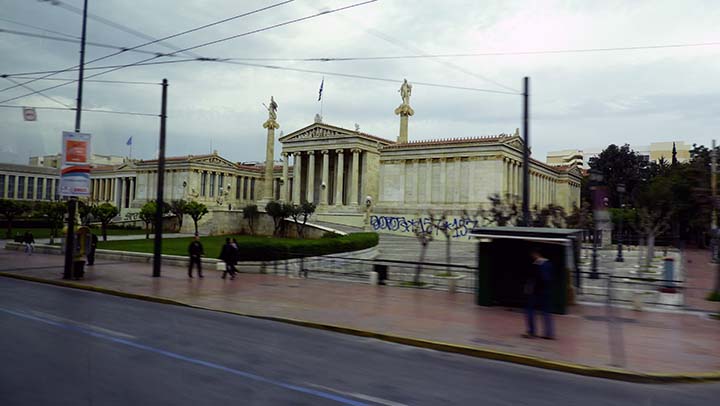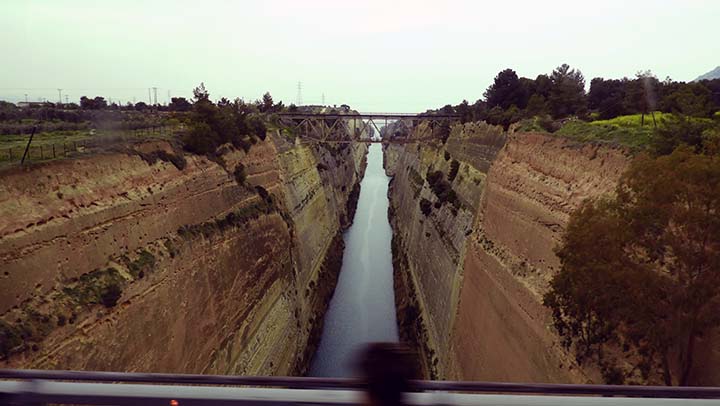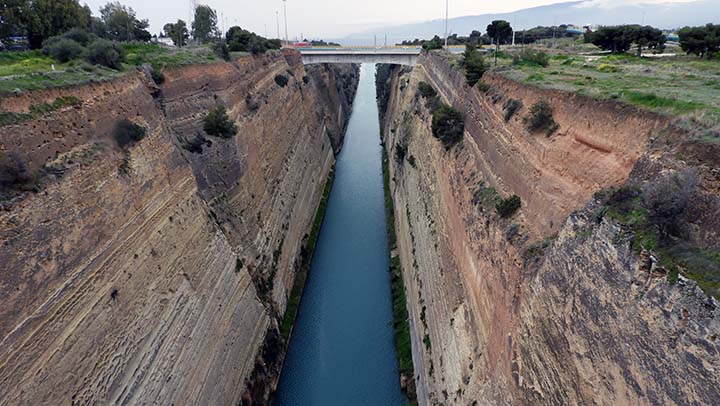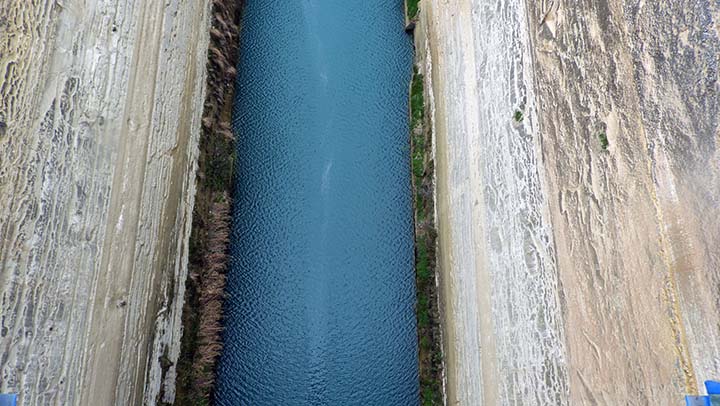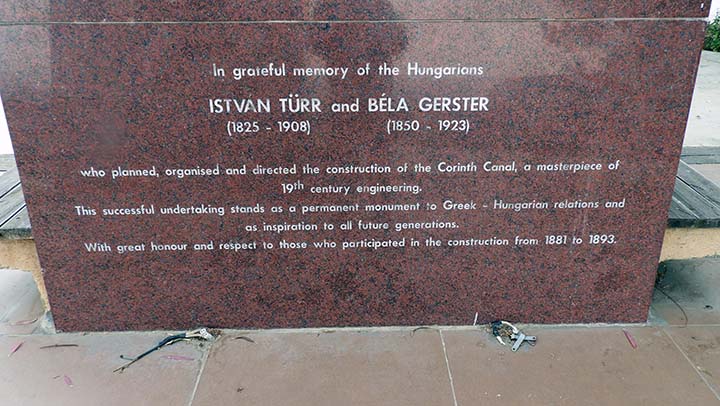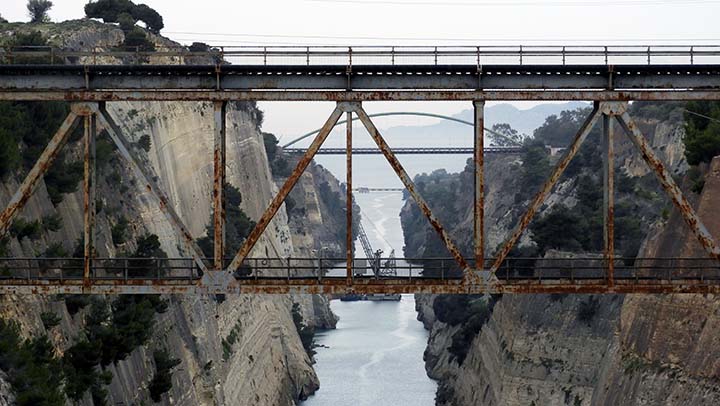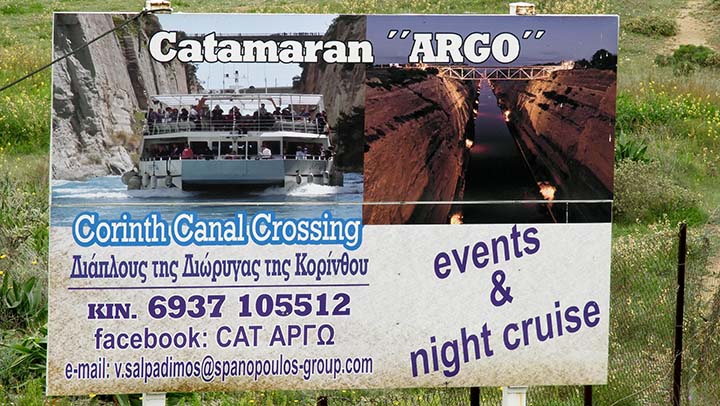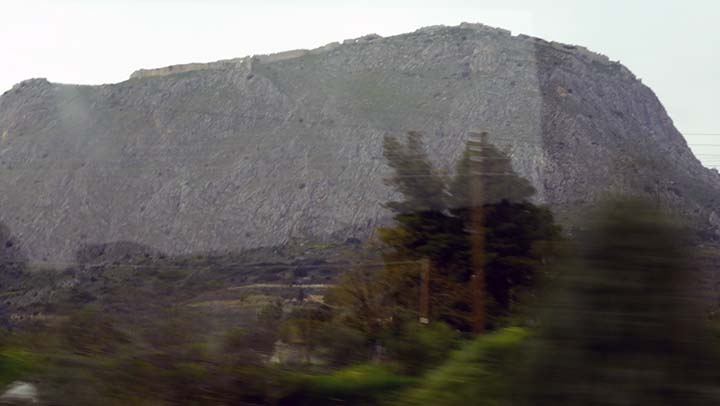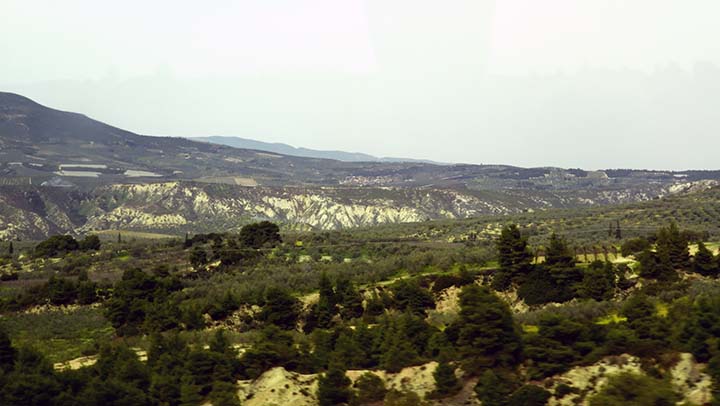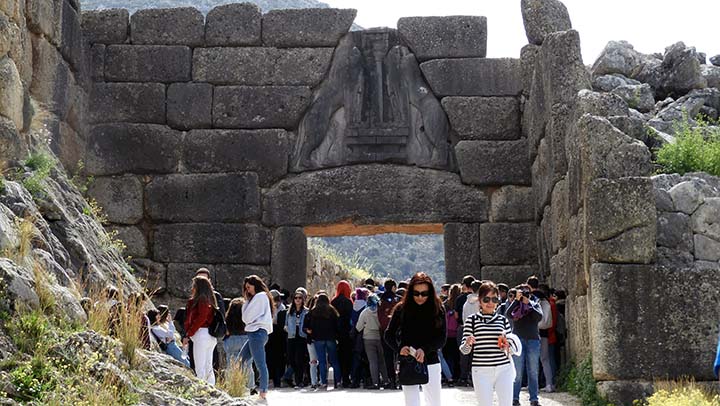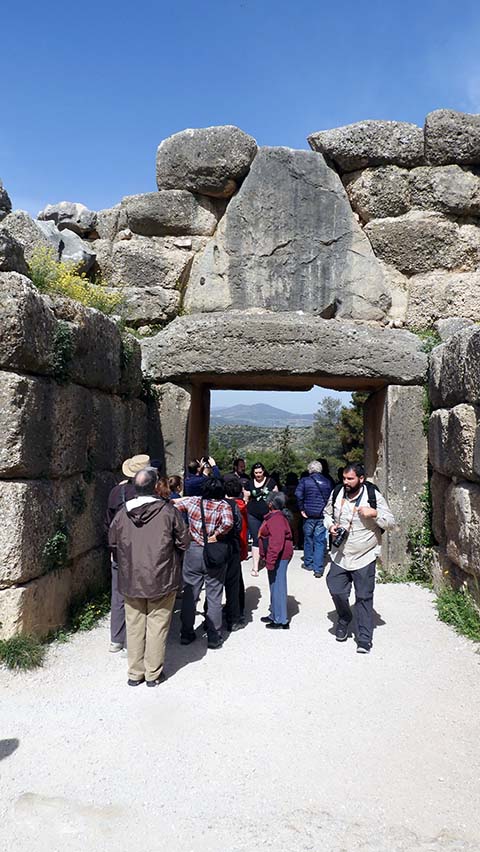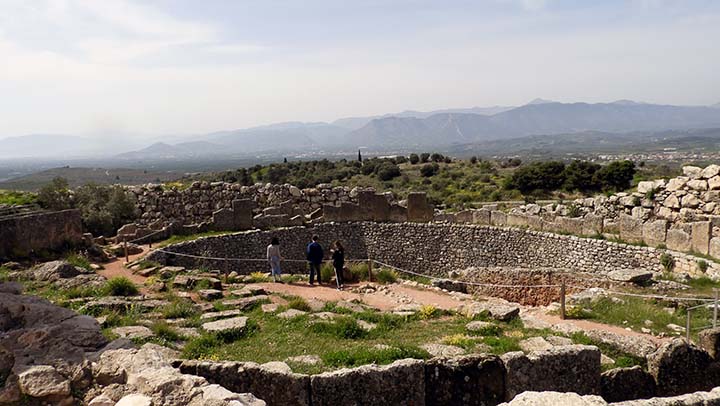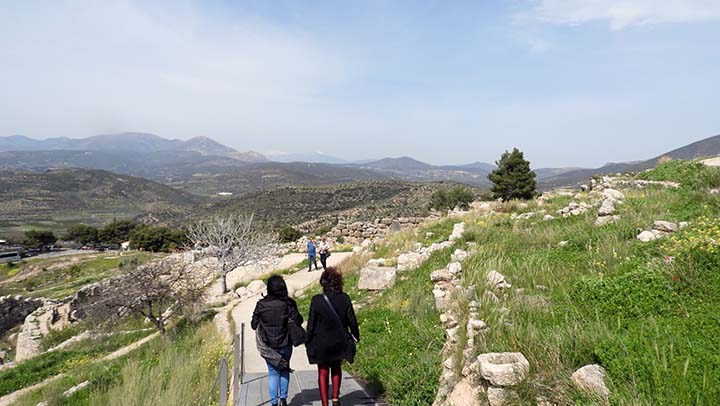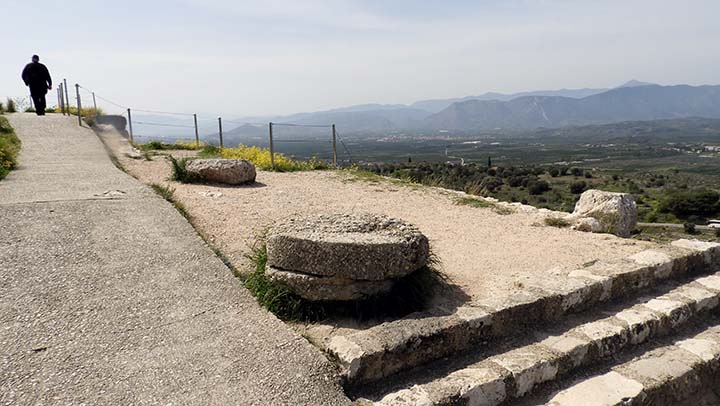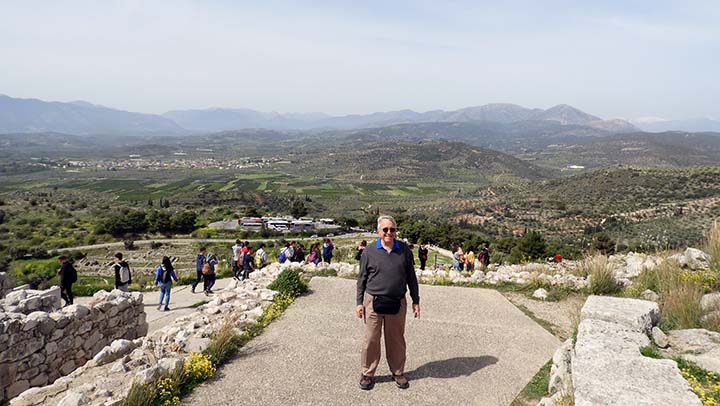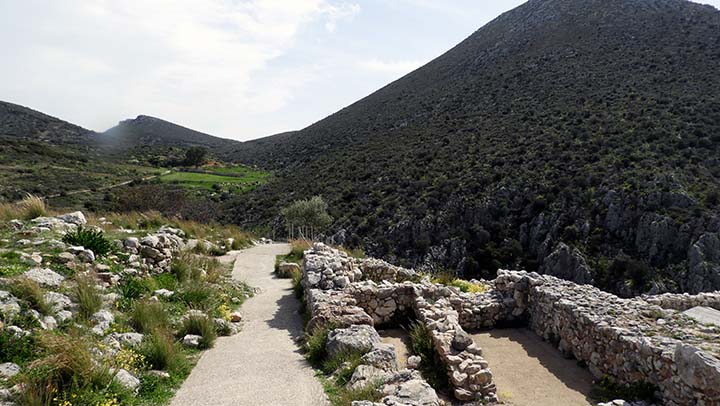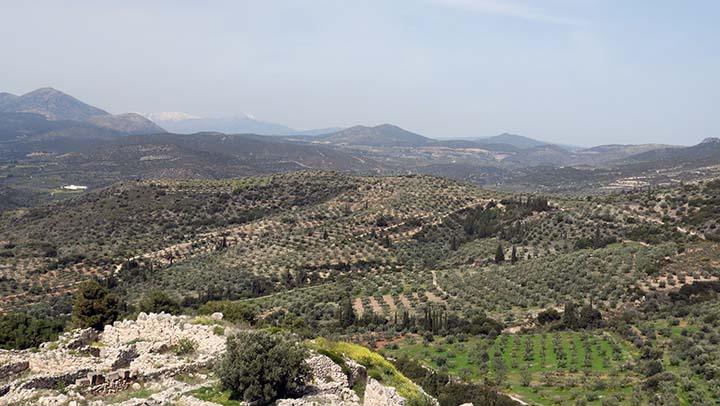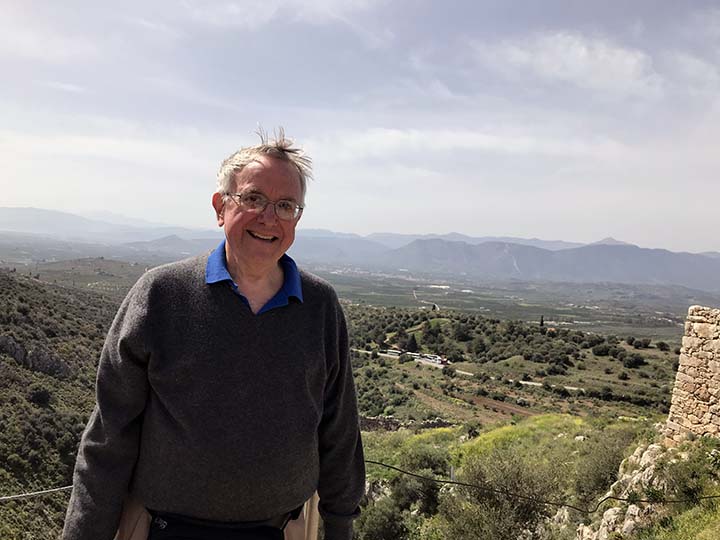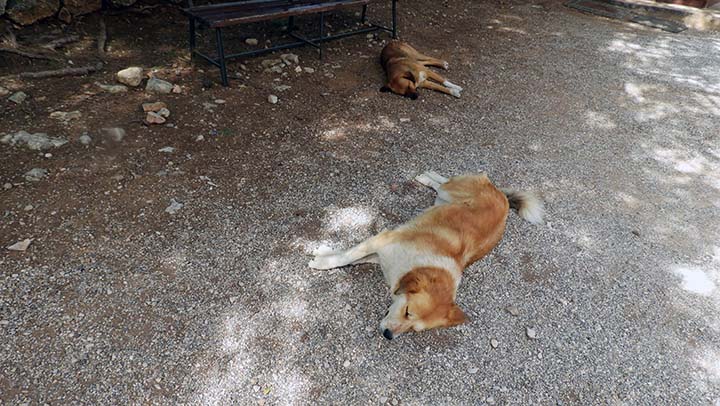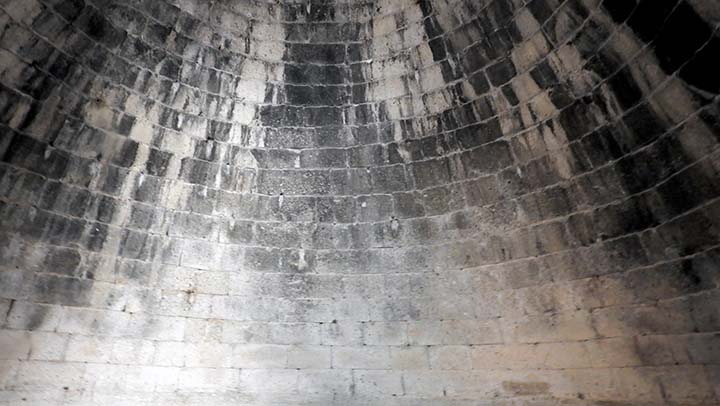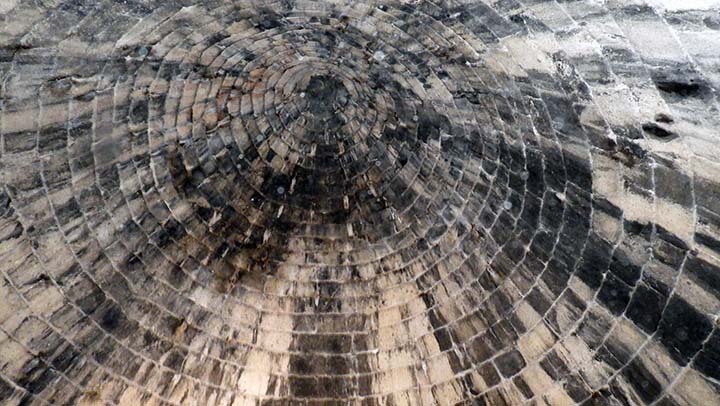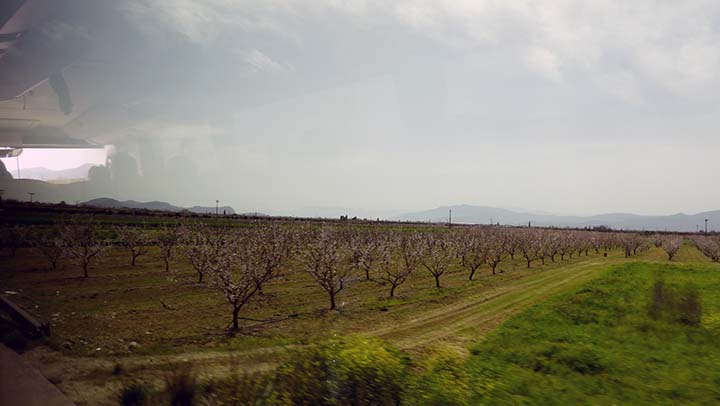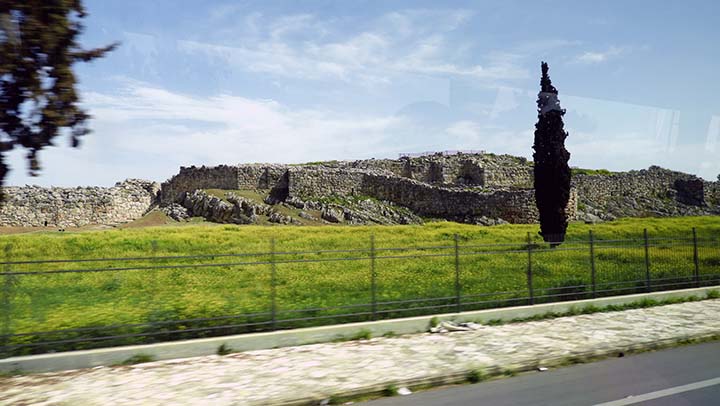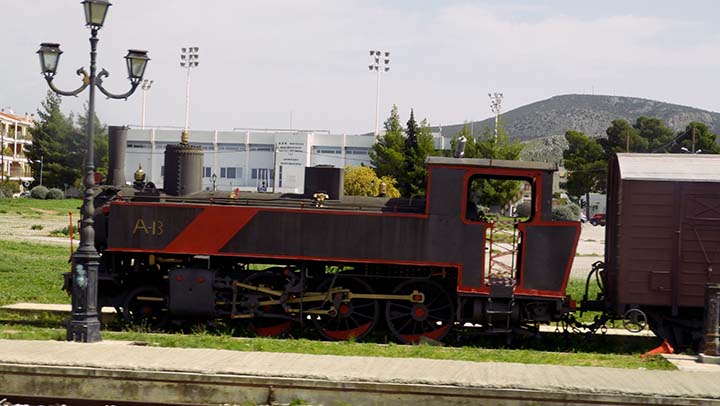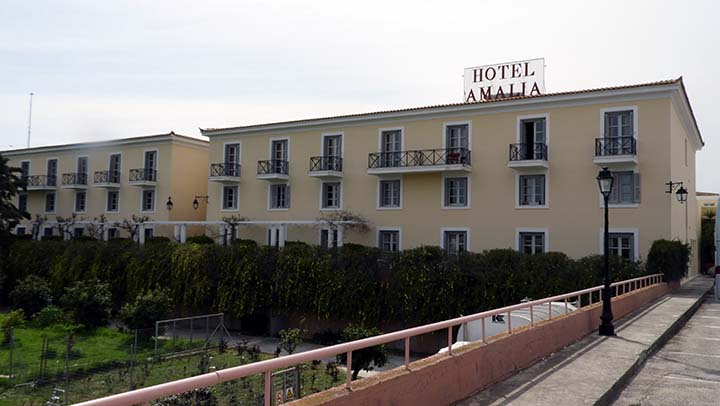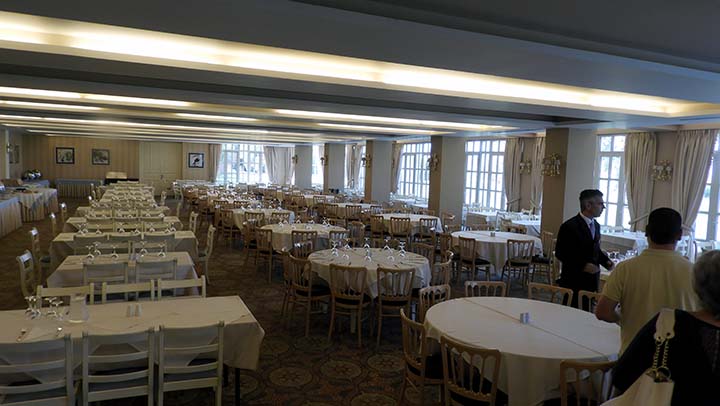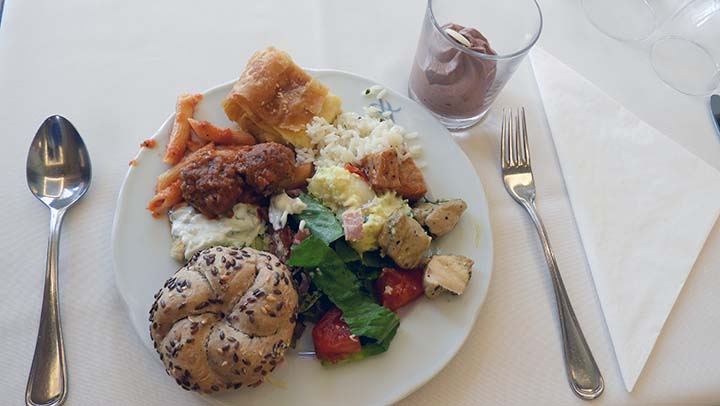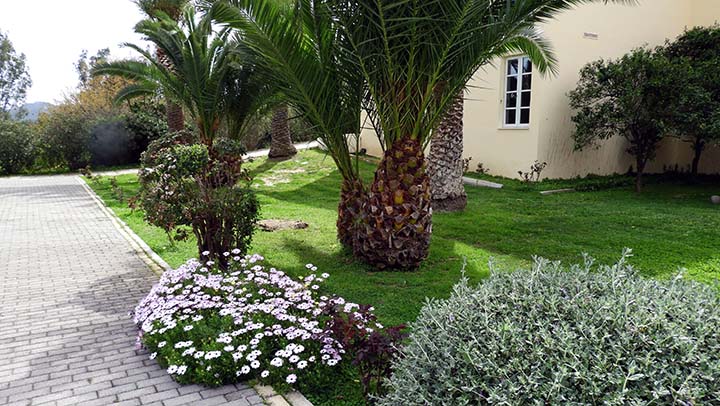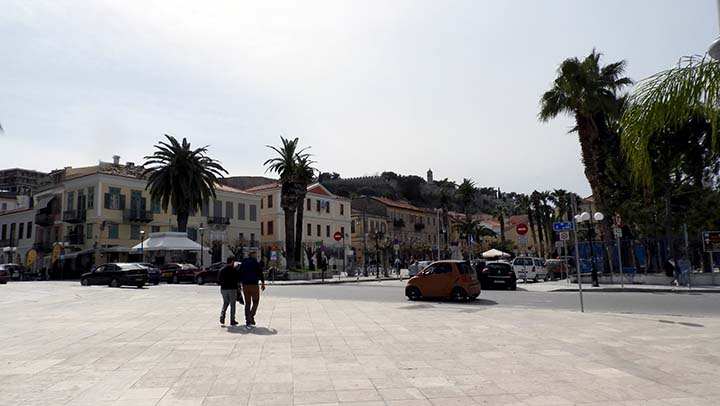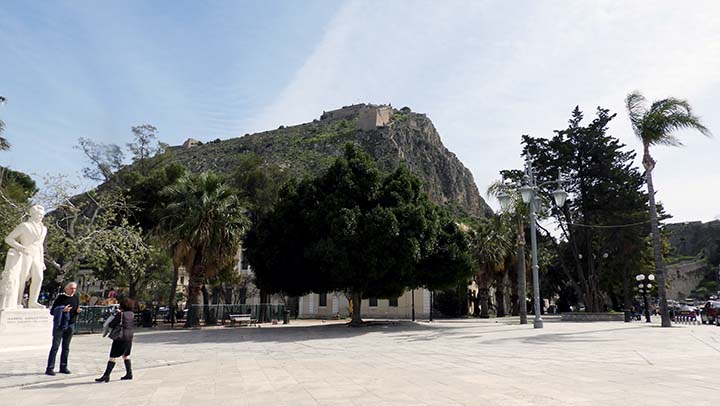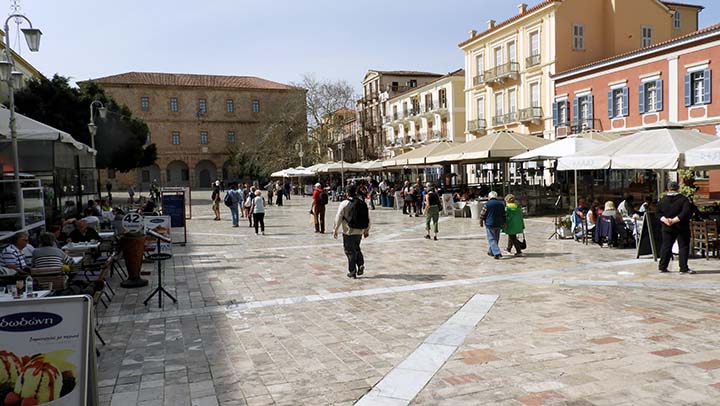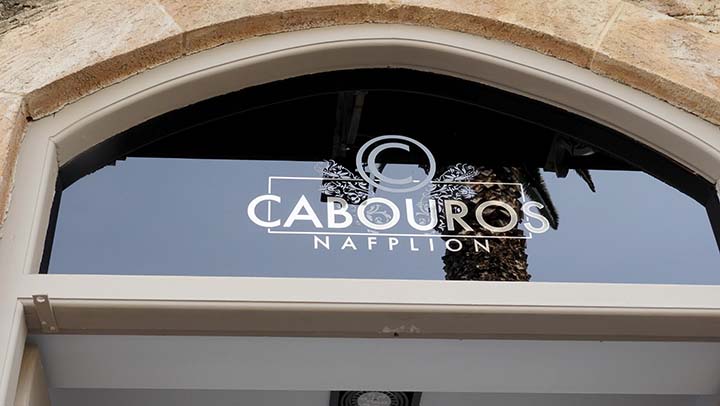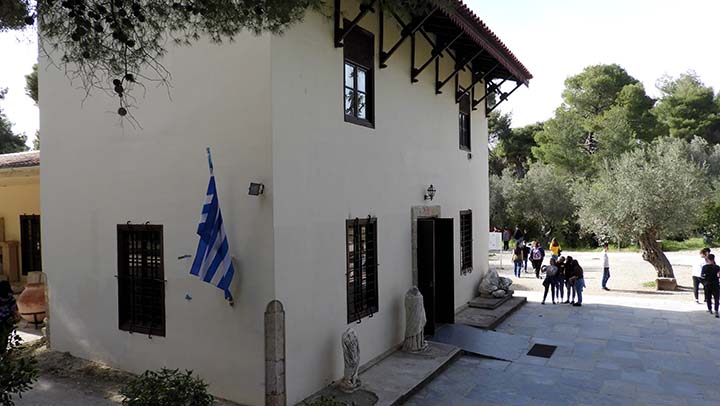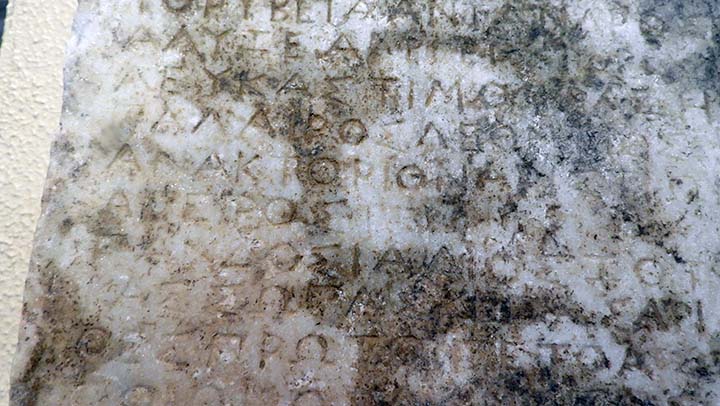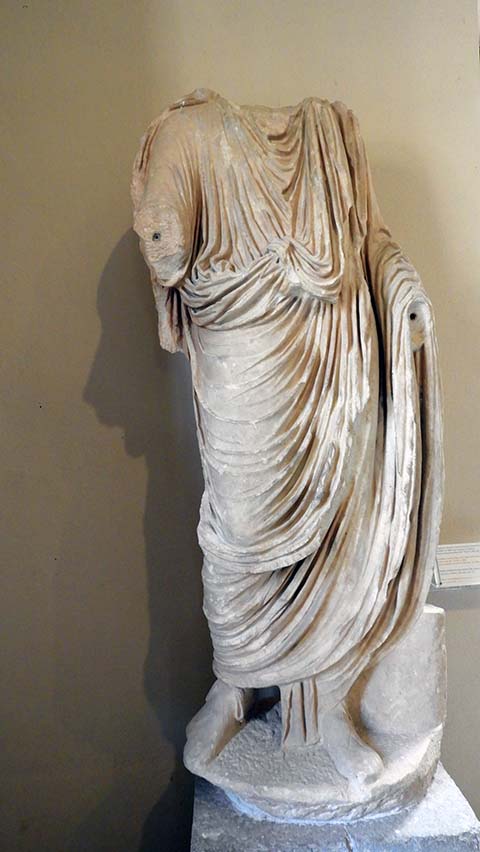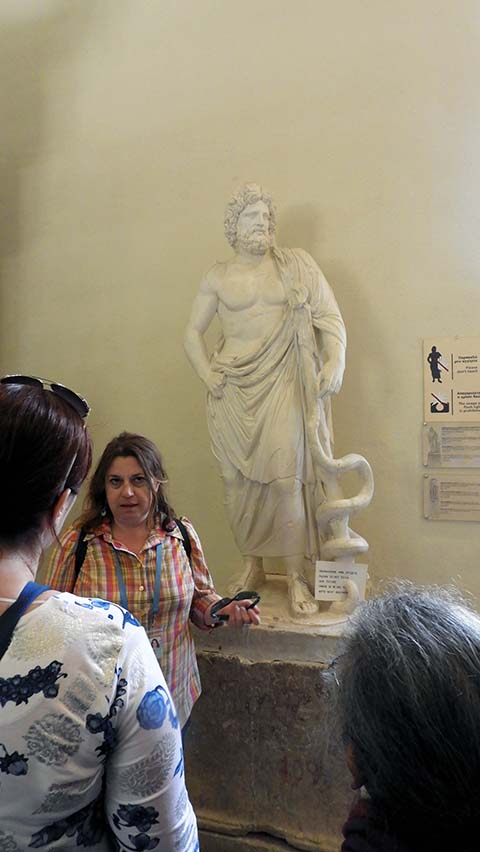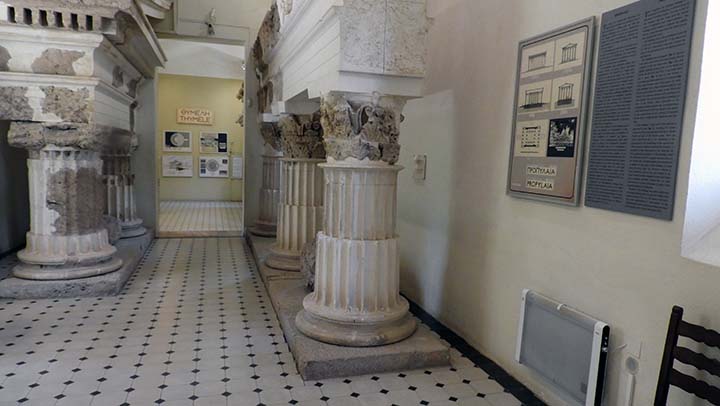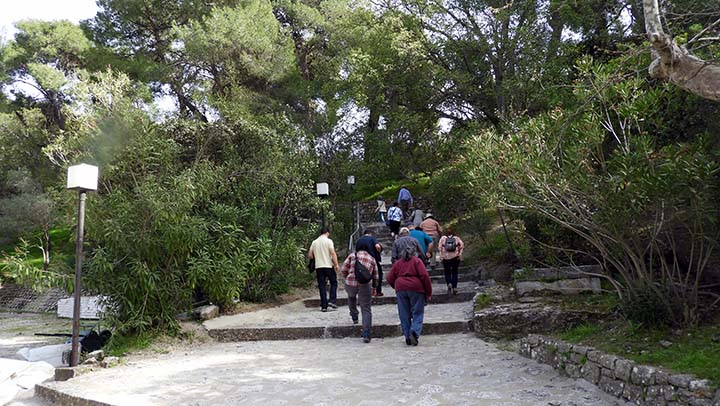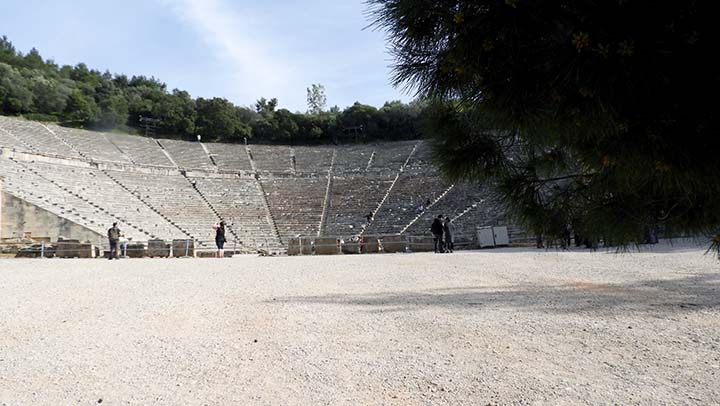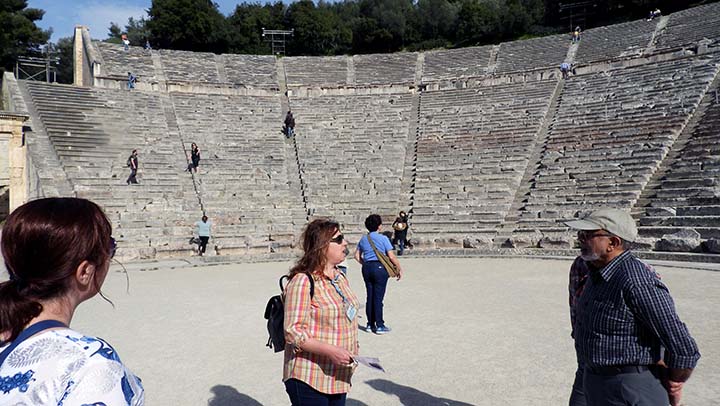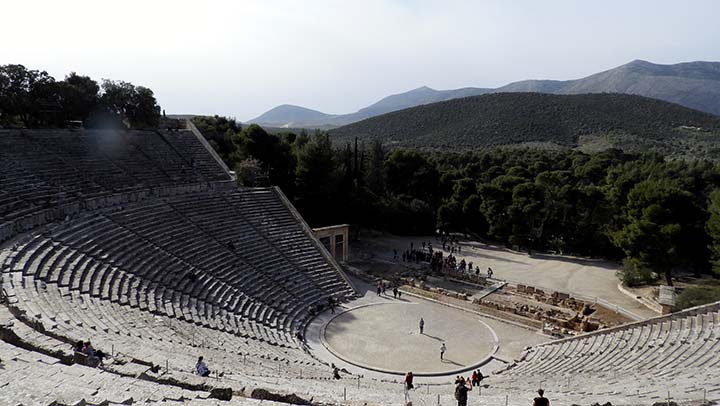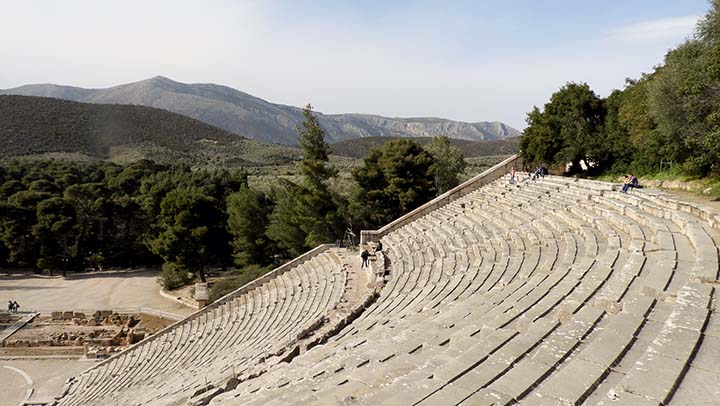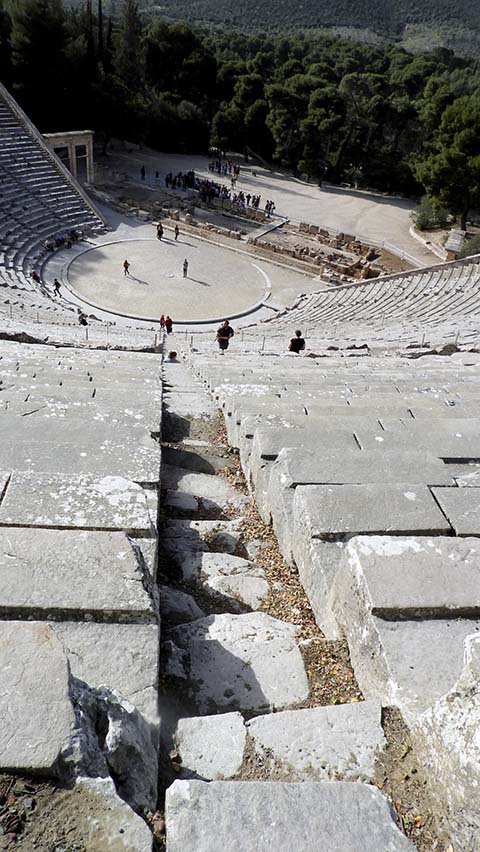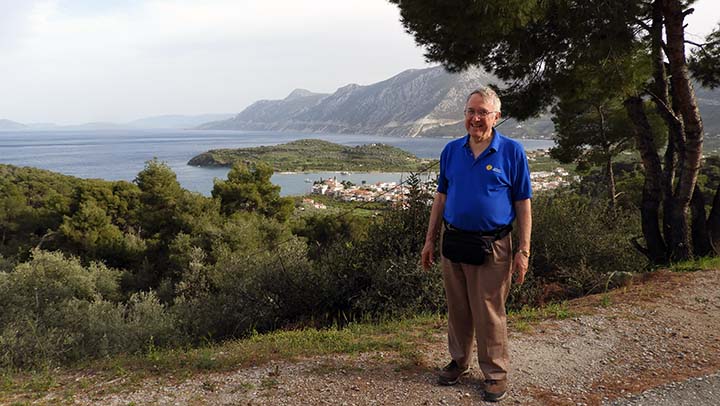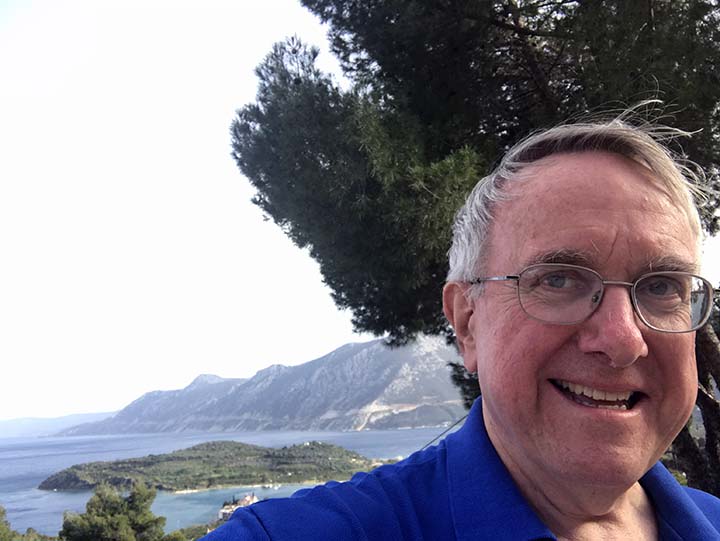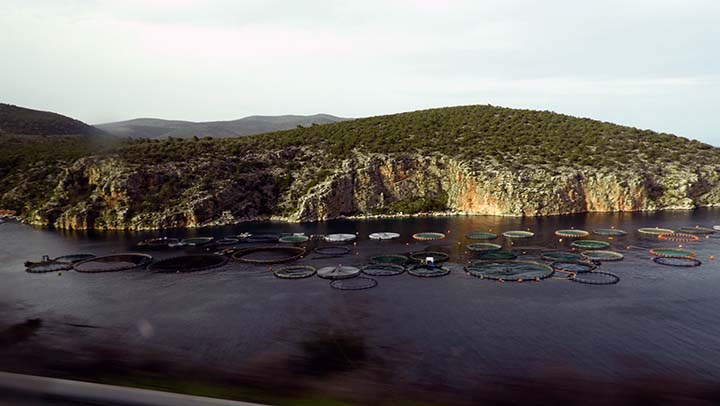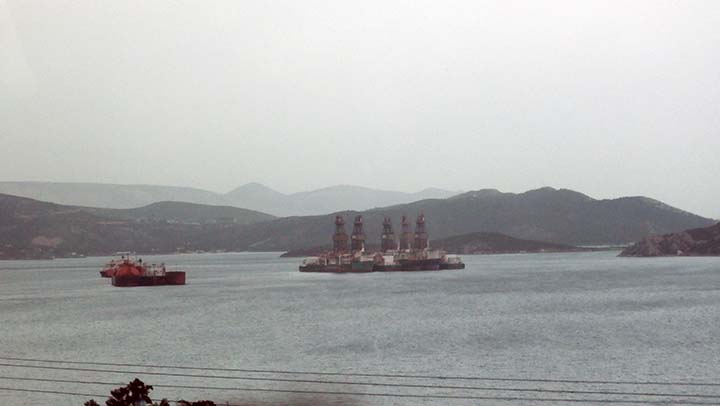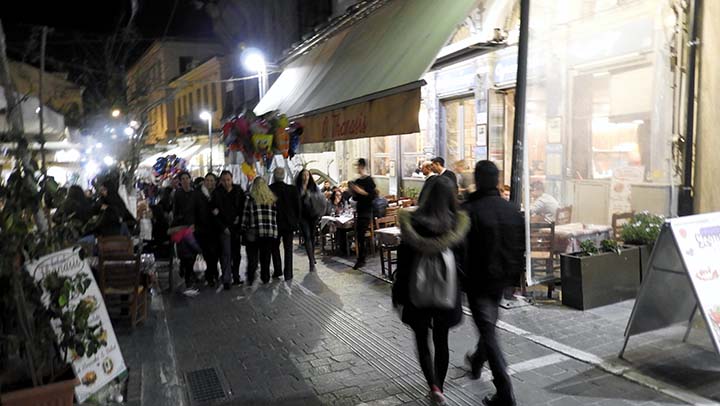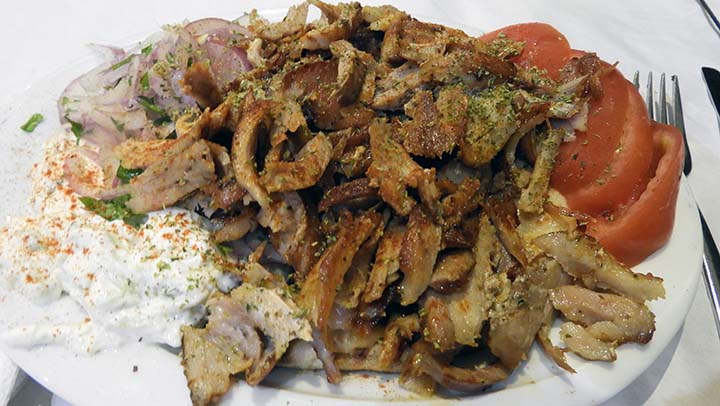|
Bill's all on his own now; no more Road Scholar. Will he have a good time on a Chat Tours visit to Mycenae? You better believe it.
The tour starts just up that hill and around the corner from Bill's hotel, and along the way he's stopped at a coffee shop.
Remember that pastry Eleni spoke so highly of, the one Bill never got to try in Heraklion? Bugatsa? Well, guess what? They sell the stuff here.
OMG it is so warm and so wonderful. Bugatsa. Maybe my favorite Greek food of all. Custard pie with phyllo. OMG.
We're now headed out of town on the Chat Tours bus and we can see the hallmark of public spaces in Athens: graffiti. It's everywhere and it's ugly and everybody agrees it's ugly, but still it's everywhere. Too bad. Athens is otherwise a lovely city.
All my life I've read about the Peloponnesian Peninsula but until I was actually there I didn't realize how ... interesting ... the geography is. See how the red area, the Peloponnese, it attached to the mainland by only a tiny strip of land? See how it gets so narrow it looks like it'll snap off? Well it's just that little bit of land that makes the Peloponnese a peninsula instead of an island. But guess what?
Ever since the Corinth Canal was cut in 1893. it really has been an island!
The builders dug the canal through the Isthmus at sea level; no locks are employed. It is 6.4 kilometers (4 mi) in length and only 21.4 meters (70 ft) wide at its base, making it impassable for most modern ships. It now has little economic importance.
The canal was initially proposed in classical times and a failed effort was made to build it in the 1st century AD. Construction started in 1881 but was hampered by geological and financial problems that bankrupted the original builders. It was completed in 1893 but, due to the canal's narrowness, navigational problems and periodic closures to repair landslides from its steep walls, it failed to attract the level of traffic expected by its operators. The canal is now used mainly for tourist traffic.
You can walk across the canal on this bridge.
And you can attach padlocks and tie hankies to the bridge to express your undying love if you have any undying love which if you choose to express it by attaching padlocks and tying hankies to bridges I'll just bet you don't.
It's a long way down there. You know, you could, if you wanted, express your undying love by just holding hands and looking down. Then there'd be a lot less unsightly mess on bridges around the world. Just sayin'.
There's a monument here.
And the other bridges seem a lot closer when you use a telephoto lens.
And you really can take a cruise with other tourists. If you want. Which Bill didn't. And that was good, because...
...it was time to get in the bus and hit the road again. That's an acropolis, the highest point in town. See the fort up there? Practically every town has an acropolis, but it's only the one in Athens that's considered "The Acropolis."
Pretty mountains.
Pretty valleys.
Pretty towns in pretty valleys below pretty mountains.
Hey, look up on that hill. I think we've arrived.
Mycenae is an archaeological site near Mikines in Greece, located about 90 kilometers (56 miles) southwest of Athens, in the north-eastern Peloponnese. Argos is 11 kilometers (7 miles) to the south; Corinth, 48 kilometers (30 miles) to the north. From the hill on which the palace was located, one can see across the Argolid to the Saronic Gulf.
Bill was amused by how much the tourists at Mycenae looked like ants on an ant hill.
In the second millennium BC, Mycenae was one of the major centers of Greek civilization, a military stronghold which dominated much of southern Greece and parts of southwest Anatolia. The period of Greek history from about 1600 BC to about 1100 BC is called Mycenaean in reference to Mycenae. At its peak in 1350 BC, the citadel and lower town had a population of 30,000 and an area of 32 hectares.
The first correct identification of Mycenae in modern literature was during a survey conducted by Francesco Grimani, commissioned by the Provveditore Generale of the Kingdom of the Morea in 1700, who used Pausanias's description of the Lion Gate to identify the ruins of Mycenae. Pausanias was the Greek writer who flourished in the C2nd A.D. His Description of Greece in ten books is a traveller's account of sights of historical and cultural interest in the Peloponnese and central Greece. Pausanias provides a comprehensive catalogue of temples and shrines in the region, as well as frequent discussions of local myth and cult practice. Here's what he said: "It was jealousy which caused the Argives to destroy Mycenae. For at the time of the Persian invasion the Argives made no move, but the Mycenaeans sent eighty men to Thermopylae who shared in the achievement of the Lacedaemonians. This eagerness for distinction brought ruin upon them by exasperating the Argives. There still remain, however, parts of the city wall, including the gate, upon which stand lions. These, too, are said to be the work of the Cyclopes, who made for Proetus the wall at Tiryns." See the lions up there, on top of the gate?
OK, look closer. The Lion Gate was the main entrance of the Bronze Age citadel of Mycenae, southern Greece. It was erected during the 13th century BC in the northwest side of the acropolis and is named after the relief sculpture of two lionesses or lions in a heraldic pose that stands above the entrance. The Lion Gate is the sole surviving monumental piece of Mycenaean sculpture, as well as the largest sculpture in the prehistoric Aegean. It is the only monument of Bronze Age Greece to bear an iconographic motif that survived without being buried underground, and the only relief image which was described in the literature of classical antiquity, such that it was well known prior to modern archaeology.
Bill strikes a heraldic pose at the Lions Gate.
There are no lions on the back side of the gate, but the lighting is better for taking photos.
That's a pit grave.
Our Chat Tours guide explains it all.
You know what Knossos had that this place doesn't have? Those phony baloney Disneyland reconstructions, that's what. Bill's started to wonder if he'd like to see something like that here.
Once there were columns here, but now they are gone.
Bill pretends he's a Mycenaean king. He is the master of all he surveys.
Which, at this point, ain't much.
Eleni said the Mycenaeans took over the Minoan civilization when it was in decline. There's not much left of either place now.
But there are olive trees.
And tourists.
Enough of this...let's go.
I'd never heard of the Treasury of Atreus, but here we are.
Bill, let them lie.
The Treasury of Atreus or Tomb of Agamemnon is a large "tholos" tomb on the Panagitsa Hill at Mycenae, Greece, constructed during the Bronze Age around 1250 BC. The lintel stone above the doorway weighs 120 tons, with approximate dimensions 8.3 x 5.2 x 1.2m, the largest in the world. The tomb was used for an unknown period. Mentioned by Pausanias, it was still visible in 1879 when the German archeologist Heinrich Schliemann discovered the shaft graves under the 'agora' in the Acropolis at Mycenae. The tomb has probably no relationship with either Atreus or Agamemnon, as archaeologists believe that the sovereign buried there ruled at an earlier date than the two; it was named thus by Heinrich Schliemann and the name has been used ever since.
The interior walls slope upward.
And they come to a point at the top, giving the whole thing the appearance of a beehive.
Which is perfect, because the place is FULL OF BEES! Get out of there, Bill.
Bill tried to get a picture of blossoming orange trees. Can you see the blossoms? Sorta?
There are some old ruins by the side of the highway. I don't know what they are. I'll probably never know. That's OK at this point.
Now we're in Nafplion, where we'll have lunch and do a little walking. That's an old locomotive, I'm pretty sure.
Here we are at the Hotel Amalia, which is not the same Hotel Amalia where we met the bus this morning in Athens. This one is bigger and ... emptier. Kinda spooky. It would be a fine place for a NASA conference if it weren't in the middle of nowhere. And in Greece.
They're certainly prepared for large crowds. This is one of those places we didn't visit on the Road Scholar tour -- set up to handle busloads of tourists with decent food that's not special.
See? Not special.
This place looked like it had been built maybe in the '70s. It was nice, but had that well-used vibe.
The hotel grounds were nice. Bill walked around while the rest of the tourists were dining on food that wasn't special.
They do keep the place up.
Oranges!
Now let's walk around Nafplion. Or is it "Nafplio?" Several towns I've encountered on this trip seem to spell their names with our without a final "n," and this place is no exception. I asked Eleni about it and she just sniffed and said some people like to appear "modern." So I dunno what that's all about.
Nafplio is a seaport town in the Peloponnese in Greece that has expanded up the hillsides near the north end of the Argolic Gulf. The town was an important seaport held under a succession of royal houses in the Middle Ages as part of the lordship of Argos and Nauplia, held initially by the de la Roche following the Fourth Crusade before coming under the Republic of Venice and, lastly, the Ottoman Empire. The town was the capital of the First Hellenic Republic and of the Kingdom of Greece, from the start of the Greek Revolution in 1821 until 1834. Nafplio is now the capital of the regional unit of Argolis.
Palamidi is a fortress to the east of the Acronauplia in the town of Nafplio in the Peloponnese region of southern Greece. Nestled on the crest of a 216-metre high hill, the fortress was built by the Venetians during their second occupation of the area (1686–1715). The fortress was a very large and ambitious project, but was finished within a relatively short period from 1711 until 1714. It is a typical baroque fortress based on the plans of the engineers Giaxich and Lasalle. In 1715 it was captured by the Turks and remained under their control until 1822, when it was captured by the Greeks.
Tourism emerged slowly in the 1960s, but not to the same degree as some other Greek areas. Nevertheless, it tends to attract a number of tourists from Germany and the Scandinavian countries in particular. Nafplio enjoys a very sunny and mild climate, even by Greek standards, and as a consequence has become a popular day or weekend road-trip destination for Athenians in wintertime.
There were tourists all over the place.
And gelato! Bill had a cup of the limon because he favors tart gelati. Mmmmm.
Nafplio is a port, with fishing and transport ongoing, although the primary source of local employment currently is tourism, with two beaches on the other side of the peninsula from the main body of the town and a large amount of local accommodation.
And it's "Nafplion." I knew it!
Count Ioannis Antonios Kapodistrias (10 or 11 February 1776 – 9 October 1831), sometimes anglicized as John Capodistrias, was a Greek statesman who served as the Foreign Minister of the Russian Empire and was one of the most distinguished politicians and diplomats of Europe. After a long and distinguished career in European politics and diplomacy he was elected as the first head of state of independent Greece (1827–31). He is considered as the founder of the modern Greek state. And he's a hometown boy!
Here's the museum at the Asclepeion of Epidaurus. "Where?," you say? I'm glad you asked. Epidaurus was a small city (polis) in ancient Greece, on the Argolid Peninsula at the Saronic Gulf. Epidaurus was known for its sanctuary situated about five miles (8 km) from the town, as well as its theater, which is once again in use today. The cult of Asclepius at Epidaurus is attested in the 6th century BC, when the older hill-top sanctuary of Apollo Maleatas was no longer spacious enough. The asclepeion at Epidaurus was the most celebrated healing center of the Classical world, the place where ill people went in the hope of being cured. To find out the right cure for their ailments, they spent a night in the enkoimeteria, a big sleeping hall. In their dreams, the god himself would advise them what they had to do to regain their health. Within the sanctuary there was a guest house with 160 guestrooms. There are also mineral springs in the vicinity, which may have been used in healing. Asclepius, the most important healer god of antiquity, brought prosperity to the sanctuary, which in the 4th and 3rd centuries BC embarked on an ambitious building program for enlarging and reconstruction of monumental buildings. Fame and prosperity continued throughout the Hellenistic period. After the destruction of Corinth in 146 BC Lucius Mummius visited the sanctuary and left two dedications there. In 87 BC the sanctuary was looted by the Roman general Sulla. In 74 BC a Roman garrison under Marcus Antonius Creticus had been installed in the city causing a lack of grain. Still, before 67 BC the sanctuary was plundered by pirates. In the 2nd century AD the sanctuary enjoyed a new upsurge under the Romans, but in AD 395 the Goths raided the sanctuary. Even after the introduction of Christianity and the silencing of the oracles, the sanctuary at Epidaurus was still known as late as the mid 5th century, although as a Christian healing center.
So let's look inside the museum. The first thing we see is an ancient plaque with inscriptions. It was found just outside the entrance to the asclepeion. And what does it say?
Well it's a list of donors, of course. "Our thanks to these wonderful people without whose generous support this hospital would never have been possible." Or something like that.
The statuary found nearby is, as usual, remarkably lifelike.
And old. Remarkably old.
Asclepius was a hero and god of medicine in ancient Greek religion and mythology. Asclepius represents the healing aspect of the medical arts; his daughters are Hygieia ("Hygiene", the goddess/personification of health, cleanliness, and sanitation), Iaso (the goddess of recuperation from illness), Aceso (the goddess of the healing process), Aglæa/Ægle (the goddess of the glow of good health), and Panacea (the goddess of universal remedy). He was one of Apollo's sons, sharing with Apollo the epithet Paean ("the Healer"). The rod of Asclepius, a snake-entwined staff, remains a symbol of medicine today. Our Chat Tours guide explains it all.
That's a Corinthian capital, which makes sense, this close to Corinth.
I think some of those columns have been shortened to fit into the museum.
Now let's go see the famous amphitheater.
It's going to be windy here.
The prosperity brought by the asclepeion enabled Epidaurus to construct civic monuments, including the huge theatre that delighted Pausanias for its symmetry and beauty, used again today for dramatic performances, the ceremonial hestiatoreion (banqueting hall), and a palaestra. The ancient theatre of Epidaurus was designed by Polykleitos the Younger in the 4th century BC. The original 34 rows were extended in Roman times by another 21 rows. As is usual for Greek theatres (and as opposed to Roman ones), the view on a lush landscape behind the skênê is an integral part of the theatre itself and is not to be obscured. It seats up to 14,000 people. The theatre is admired for its exceptional acoustics, which permit almost perfect intelligibility of unamplified spoken words from the proscenium or skēnē to all 14,000 spectators, regardless of their seating. Famously, tour guides have their groups scattered in the stands and show them how they can easily hear the sound of a match struck at center-stage. A 2007 study by Nico F. Declercq and Cindy Dekeyser of the Georgia Institute of Technology indicates that the astonishing acoustic properties may be the result of the advanced design: the rows of limestone seats filter out low-frequency sounds, such as the murmur of the crowd, and also amplify the high-frequency sounds of the stage.
Our Chat Tours guide promised to demonstrate the fantastic acoustics of this place if we'd go up and sit in the seats.
Way up there? Seriously?
OK, Bill climbed to the top. So where's our Chat Tours guide? She's disappeared! Oh well, it was good exercise.
And there was a nice view.
But the wind kicked up. Boy did the wind ever kick up.
And it was a long way back down.
We stopped along the road back to Athens to take some pretty pictures.
Bill just loves to see himself in pretty pictures. The town down below is Old Epidaurus which, and let me make this as perfectly clear as our Chat Tours guide did, is not the same as New Epidaurus.
And don't forget your selfie, Bill. You know, you're getting pretty good at this.
That's a fish farm.
And that's something really big in the bay.
Even the telephoto lens didn't help Bill figure out what he was seeing. But those ships sure did seem to like those big towers, whatever they were.
Back to the hotel and then back to Plaka and then back to Thanasis where Bill plans to get that gyro he wants for dinner.
See the gyros up there in the window? Why is it called "gyro?" Because it turns like a gyroscope, of course.
And it looks so good and it smells so good.
But it still isn't exactly a sandwich, even though all the parts are there. It's delicious, though.
And look! When Bill arrives back at the hotel he finds there's a service going on in that little church in the hotel driveway. Nice. He never got inside to see if there were frescoes, though. Bill hated the thought of missing a fresco.
|




